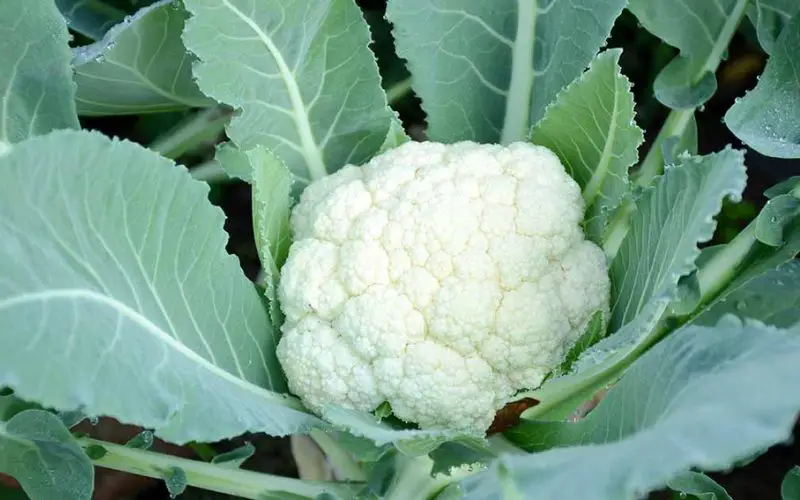Cabbage, broccoli, and cauliflower are “cousins.” They belong to the same family of plants. Cauliflower translates to cabbage flower in Latin.
The cauliflower head has tightly bunched florets connected to a thick core, much like broccoli, but one difference between the two only produces one head at a time.
The head of the cauliflower, usually curd, is the only edible part of the plant and can come in various colors. Cauliflower is not easy to grow because it Ghostwriter requires optimum growth conditions. If not, it will not yield a good harvest.
Nutritional Facts Of Cauliflower
Cauliflower is highly nutritious and has lots of nutrients in it. Typically 100g (3.5 oz) of raw cauliflower has the following nutrients:
- Energy – 104 kJ (25 kcal)
- Carbohydrates – 5 g
- Sugars – 1.9 g
- Dietary fiber – 2 g
- Fat – 0.3 g
- Protein – 1.9 g
- Vitamins: The percentage of recommended daily value it contributes:
- Thiamine (B1) – 4% 0.05 mg
- Riboflavin (B2) – 5% 0.06 mg
- Niacin (B3) – 3% 0.507 mg
- Pantothenic acid (B5) – 13% 0.667 mg
- Vitamin B6 – 14% 0.184 mg
- Folate (B9) – 14% 57 μg
- Vitamin C – 58% 48.2 mg
- Vitamin E – 1% 0.08 mg
- Vitamin K – 15% 15.5 μg
- Minerals – Quantity %DV†
- Calcium – 2% 22 mg
- Iron – 3% 0.42 mg
- Magnesium – 4% 15 mg
- Manganese – 7% 0.155 mg
- Phosphorus – 6% 44 mg
- Potassium – 6% 299 mg
- Sodium – 2% 30 mg
- Zinc – 3% 0.27 mg
†Percentages are roughly approximated using U.S. recommendations for adults.
Source: USDA FoodData Central
Varieties And Colours Of Cauliflower
There are over a hundred varieties of cauliflower that are known and grown globally, but there are four major ones that are common, and they are:
1. Italian cauliflower
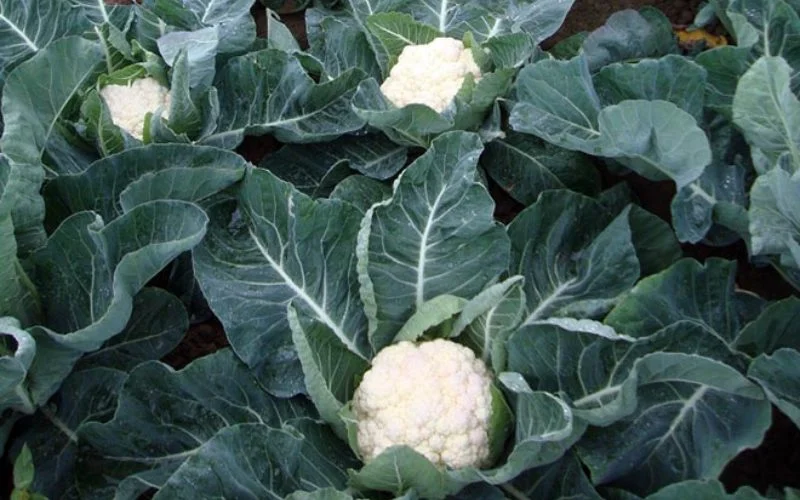
Italian cauliflower is an annual and biennial type that varies in appearance. It is believed to be the ancestral form from which other Cauliflowers were derived. It varies in color too. Hence, some of the cultivars are green, purple, brown, and yellow. Romanesco is an example of an Italian Cauliflower.
2. Asian
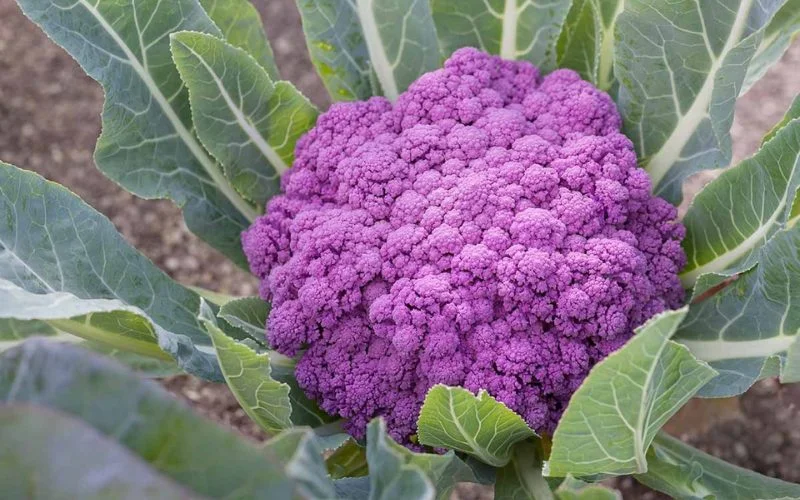
This tropical variety of cauliflower, developed in India in the 19th century, is mainly grown in India and China, including varieties like Early Patna and Early Benaras. They have different colors and appearances.
3. Northern European annuals
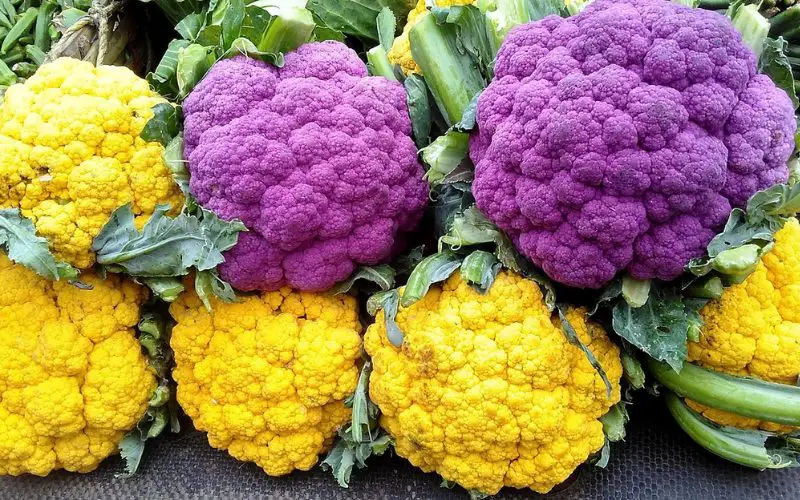
This variety was developed in Germany in the 18th century, including cultivars like snowball and Erfurt. It is mainly grown and eaten in Europe and North America for summer and fall harvest.
4. Northwest European biennial
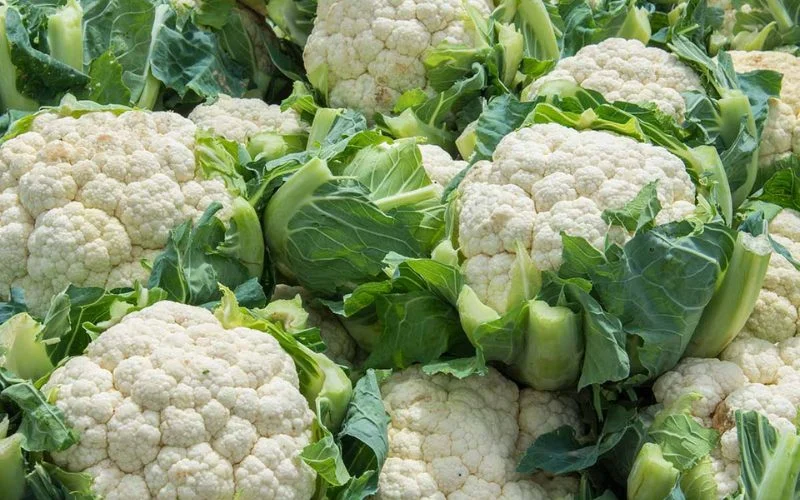
This variety, developed in the 19th century in France, is used in Europe for winter and early spring harvests. An example of this variety includes Roscoff and Anger.
Cauliflower comes in 4 primary colors, and they are
1. White
It is the most common color associated with cauliflower. The curd for the “head” of the cauliflower is white, while the leaves surrounding it are green.
2. Orange
Orange cauliflower has a Rich supply of beta-carotene, which is responsible for its color. This hue of cauliflower is believed to have originated in Canada as a natural mutant. Examples of this cauliflower include ‘orange Bouquet’ and cheddar.
3. Green
Many will confuse this type of cauliflower with broccoli because of its color; hence, sometimes, people call it broccoflower.
Example of this cauliflower includes Vorda, Alverda, and Green Goddess. It is available in the standard curd shape with a fractal spiral curd called Romanesco broccoli. It is very commonly grown in Europe and the U.S.
4. Purple
This type of cauliflower contains Anthocyanins, a water-soluble pigment that imparts the purple color. Varieties include ‘Graffiti’ and ‘Purple Capes.’
Culinary Merits Of Cauliflower
Records show that between 2012 and 2016, the amount of cauliflower produced in the United States increased to 63%. It also states that there is an increase to the tune of 71% of the increase in sales of cauliflower-based products sales from 2017 to 2018. Hence if we say that cauliflower is fast becoming a staple for many people, especially those who love to eat right, you can be sure it is no exaggeration.
Cauliflower is a very versatile food that can be prepared and eaten in a number of ways. They can be roasted, grilled, boiled, fried, steamed, pickled, or raw. That means you can enjoy this nutrient-packed vegetable in so many ways than one.
As if these culinary advantages are not enough, this vegetable is trendy for many reasons. It is a gluten-free, low-calorie vegetable and an excellent carbohydrate alternative to rice or wheat flour.
Today we have chefs who cook mashed cauliflower as a low-carb alternative to mashed potatoes, those who use as a healthier option than rice and flour and so use it in making pizza crust and other such food.
Cauliflower rice is made by pulsing cauliflower florets and cooking the result in oil. When cooking cauliflower, the outer leaves and thick stalks are removed, which leaves only the florets, the head of the cauliflower that people eat.
How To Grow Cauliflower
Cauliflower is not easy to grow, especially if you are a beginner gardener. That is because it needs a suitable growth environment to thrive.
Best Climatic Condition
The weather is the main factor that affects your cauliflower. This plant loves moderate daytime temperatures of 21–29 °C (70–85 °F). They require full sun and moist sandy soil with high amounts of organic matter.
When to Plant Cauliflower
You can plant cauliflower in the fall or spring, and if you are growing the plant from seed, then you must sow the seeds indoors 4 to 5 weeks before the last spring frost date, but if you are planning seedlings, then you can plant the seedlings outdoors 2 to 4 weeks before the last spring frost date.
Planting cauliflower in fall should be done 6 to 8 weeks before the first fall frost date but after daytime temperatures are below 75°F.
Planting Cauliflower
It is best to plant cauliflower from a seedling that you can find online or in stores because growing them from seeds is quite tasking, and the success rate can be low. So if you get your Cauliflower seedlings, you must plant them in compost-rich bedding or apply 5-10-10 fertilizers to the planting site.
Fertile soil helps to prevent Cauliflower heads from buttoning, which forms multiple tiny florets instead of one big curd.
Plant cauliflower from seeds in containers like flats, hotbeds, or the field if you are growing cauliflower. The soil should be loose, well-drained, and fertile, and plant the seeds 3 to 6 inches apart.
When the seeds have grown to become seedlings after about 25 to 35 days, you can transplant them into the field.
In the field, plant the seedlings 18 to 24 inches apart with 30 inches between rows, and add mulch to help the soil retain its moisture.
You can protect the plant from frost in early spring by covering them with old milk jugs, while in summer, you can shade the plants from the hot sun, if necessary.
Caring For The Cauliflower
Now that your seedlings are established, you should water them regularly with 2 inches of water per square foot every week, and they require side-dressing the plants with a high-nitrogen fertilizer after s out 21 days of transplanting.
It will take 75 to 85 days from transplant for the cauliflower to mature, and when the head or curd is 2 to 3 inches in diameter, you will have to blanch the cauliflower.
Blanching is simply tying the outer leaves of the cauliflower together over the head and then securing it with a rubber band, twine, or tape to keep light out so that they don’t lose their color and turn brown.
Time to Harvest
It takes about 50 to 100 days for the cauliflower to be ready for Harvest. Currently, the head is white, firm, and compact and about 7 inches in diameter. Harvest the curd with a knife, ensuring some leaves are on the harvested curd.
How Many Heads Of Cauliflower Per Plant
As you harvest your cauliflower, you will notice that each plant produces only one big head, weighing as much as 500 grams. Secondly, you can o ky harvest your cauliflower once because new edible heads do not form even after you harvest the head.
The weather would have changed at this time, and cauliflower does not thrive in changing temperatures. However, if you don’t dig up the whole cauliflower plant, you might be lucky to find tiny florets here and there.
Conclusion
If you love cabbages and broccoli, you will love cauliflower because they are from one family, are nutritious, and have many health benefits. Cauliflower is one of those food ingredients that are so versatile that you can use it in many recipes.
Helpful Links:
- Do Broccoli Plants Produce More Than One Head?
- How To Plant Garlic Heads (Easy Guide)
- Can You Plant The Seeds From a Sunflower Head?
- Can You Plant a Head of Lettuce (How To Plant Lettuce)
- How To Use Soil Saver Compost Bin (Easy Guide)
If you love this plant so much, why not grow it in your garden today, be sure to provide it with the optimum condition it needs. Read also How Long Does Grass Seed Take To Grow?
Do well to share this article on your social media platforms for those that will find it valuable. Follow us on Facebook, Instagram, and Pinterest for more updates.

